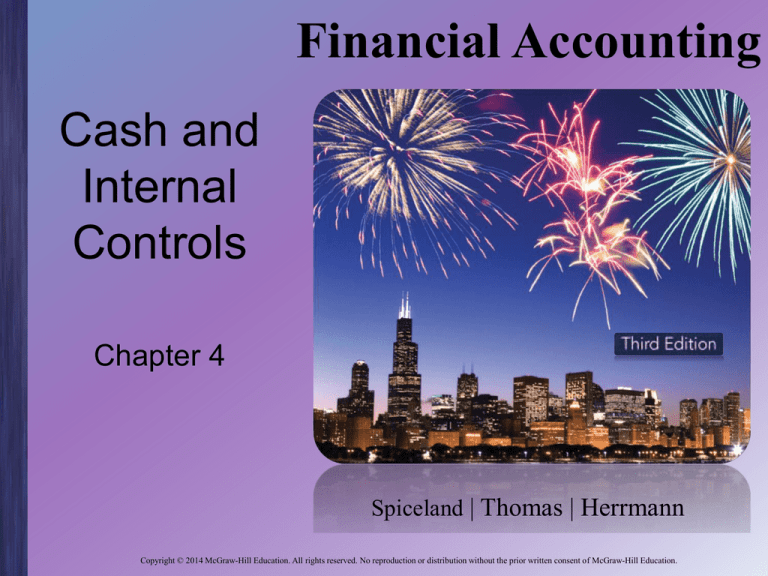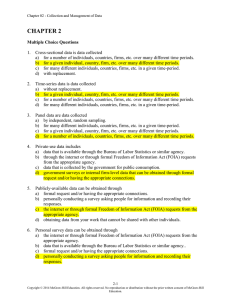
Financial Accounting
Cash and
Internal
Controls
Chapter 4
Spiceland | Thomas | Herrmann
Copyright © 2014 McGraw-Hill Education. All rights reserved. No reproduction or distribution without the prior written consent of McGraw-Hill Education.
4-2
Learning Objectives
• Discuss the impact of accounting scandals and
the passage of the Sarbanes-Oxley Act
• Identify the components, responsibilities, and
limitations of internal control
• Define cash and cash equivalents
• Understand controls over cash receipts and cash
disbursements
• Reconcile a bank statement
Copyright © 2014 McGraw-Hill Education. All rights reserved. No reproduction or distribution without the prior written consent of McGraw-Hill Education.
4-3
Learning Objectives
• Account for petty cash
• Identify the major inflows and outflows of cash
• Assess earnings quality by comparing net income
and cash flows
Copyright © 2014 McGraw-Hill Education. All rights reserved. No reproduction or distribution without the prior written consent of McGraw-Hill Education.
4-4
Part A
Internal Controls
Copyright © 2014 McGraw-Hill Education. All rights reserved. No reproduction or distribution without the prior written consent of McGraw-Hill Education.
4-5
Incorrect Financial Statements
• Reasons
• Errors—accidental errors in recording transactions
or applying accounting principles
• Fraud—a person intentionally deceives another
person for personal gain or to damage that person
• Occupational fraud: the use of one’s occupation for
personal enrichment through the deliberate misuse
or misapplication of the employer’s resources.
Copyright © 2014 McGraw-Hill Education. All rights reserved. No reproduction or distribution without the prior written consent of McGraw-Hill Education.
4-6
The Fraud Triangle
Motive
(or pressure)
Rationalization
Opportunity
Copyright © 2014 McGraw-Hill Education. All rights reserved. No reproduction or distribution without the prior written consent of McGraw-Hill Education.
4-7
Internal Controls
• Eliminate opportunity
• Represent plans to:
• Safeguard the assets
• Improve accuracy and reliability of information
Copyright © 2014 McGraw-Hill Education. All rights reserved. No reproduction or distribution without the prior written consent of McGraw-Hill Education.
4-8
Learning Objective 1
Discuss the impact of accounting scandals and the
passage of the Sarbanes-Oxley Act
Copyright © 2014 McGraw-Hill Education. All rights reserved. No reproduction or distribution without the prior written consent of McGraw-Hill Education.
4-9
Accounting Scandals and Response
by Congress
• Managers are entrusted with the resources of
both the company’s lenders and owners
• Managers act as stewards or caretakers of the
company’s assets
• Some managers have shirked their ethical
responsibilities
• Top executives misreported and fooled investors
into overvaluing the company’s stock
Copyright © 2014 McGraw-Hill Education. All rights reserved. No reproduction or distribution without the prior written consent of McGraw-Hill Education.
4-10
Accounting fraud in U.S. history
Enron
WorldCom
Avoided reporting billions in
debt and losses
Misclassified expenditures to
overstate assets and
profitability
Copyright © 2014 McGraw-Hill Education. All rights reserved. No reproduction or distribution without the prior written consent of McGraw-Hill Education.
4-11
Sarbanes-Oxley Act of 2002
• Passed by Congress
• Also known as the Public Company Accounting
Reform and Investor Protection Act of 2002
• Applies to all companies that are required to file
financial statements with the SEC
• Established guidelines on:
• Internal control procedures
• Auditor-client relations
Copyright © 2014 McGraw-Hill Education. All rights reserved. No reproduction or distribution without the prior written consent of McGraw-Hill Education.
Major Provisions of the
Sarbanes-Oxley Act of 2002
•
•
•
•
•
•
•
•
Oversight board
Corporate executive accountability
Nonaudit services
Retention of work papers
Auditor rotation
Conflicts of interest
Hiring of auditor
Internal control
Copyright © 2014 McGraw-Hill Education. All rights reserved. No reproduction or distribution without the prior written consent of McGraw-Hill Education.
4-12
4-13
Learning Objective 2
Identify the components, responsibilities, and
limitations of internal control
Copyright © 2014 McGraw-Hill Education. All rights reserved. No reproduction or distribution without the prior written consent of McGraw-Hill Education.
4-14
Control Activities
Preventive controls
Detective controls
• Separation of duties
• Reconciliations
• Physical controls
• Performance reviews
• Proper authorization
• Audits
• Employee management
• E-commerce controls
Copyright © 2014 McGraw-Hill Education. All rights reserved. No reproduction or distribution without the prior written consent of McGraw-Hill Education.
Responsibilities for Internal
Control
• The CEO and CFO to sign a report each year
assessing adequacy of internal controls
• Auditors to provide an opinion on management’s
assessment
• Auditor to express its own opinion on company’s
internal control over financial reporting
Copyright © 2014 McGraw-Hill Education. All rights reserved. No reproduction or distribution without the prior written consent of McGraw-Hill Education.
4-15
4-16
Limitations of Internal Control
• Bad employee cannot be turned into a good one
• Internal control systems are especially susceptible
to collusion
• Collusion: two or more people acting together to
circumvent internal controls.
• Top-level employees who can override internal
control procedures can commit fraud
• Effective internal controls and ethical employees
cannot ensure success or even survival
Copyright © 2014 McGraw-Hill Education. All rights reserved. No reproduction or distribution without the prior written consent of McGraw-Hill Education.
4-17
Part B
Cash
Copyright © 2014 McGraw-Hill Education. All rights reserved. No reproduction or distribution without the prior written consent of McGraw-Hill Education.
4-18
Learning Objective 3
Define cash and cash equivalents
Copyright © 2014 McGraw-Hill Education. All rights reserved. No reproduction or distribution without the prior written consent of McGraw-Hill Education.
4-19
Cash and Cash Equivalents
• Cash
•
•
•
•
Currency
Coins
Balances in savings and checking accounts
Checks
• Cash equivalents—mature within three months
• Money market funds
• Treasury bills
• Certificates of deposit
Copyright © 2014 McGraw-Hill Education. All rights reserved. No reproduction or distribution without the prior written consent of McGraw-Hill Education.
4-20
Learning Objective 4
Understand controls over cash receipts and cash
disbursements
Copyright © 2014 McGraw-Hill Education. All rights reserved. No reproduction or distribution without the prior written consent of McGraw-Hill Education.
4-21
Cash Controls
• Controls over cash receipts
• Separate duties of handling cash and verifying receipts
• Deposit cash daily
• Prefer credit cards or debit cards
• Controls over cash disbursements
• Prefer payments by check, debit card, or credit card
• Separate duties of authorizing payments and verifying
purchases
• Verify records against purchase receipts
• Place authorization and documentation procedures
• Separate disbursement and collections duties
Copyright © 2014 McGraw-Hill Education. All rights reserved. No reproduction or distribution without the prior written consent of McGraw-Hill Education.
4-22
Learning Objective 5
Reconcile a bank statement
Copyright © 2014 McGraw-Hill Education. All rights reserved. No reproduction or distribution without the prior written consent of McGraw-Hill Education.
4-23
Bank Reconciliation
• Bank reconciliation: matching the balance of
cash in the bank account with the balance of cash
in the company’s own records
Copyright © 2014 McGraw-Hill Education. All rights reserved. No reproduction or distribution without the prior written consent of McGraw-Hill Education.
4-24
Illustration 4.6—Bank Reconciliation
• Timing differences
• Errors
Copyright © 2014 McGraw-Hill Education. All rights reserved. No reproduction or distribution without the prior written consent of McGraw-Hill Education.
Step 1: Reconciling the Bank’s
Cash Balance
• Deposits outstanding: cash receipts of the
company that have not been added to the bank’s
record of the company’s balance
• Checks outstanding: checks the company has
written that have not been subtracted from the
bank’s record of the company’s balance
Copyright © 2014 McGraw-Hill Education. All rights reserved. No reproduction or distribution without the prior written consent of McGraw-Hill Education.
4-25
Step 2: Reconciling the
Company’s Cash Balance
• Interest earned by the company
• Collections made by the bank on the company’s
behalf
• Service fees
• Charges for NSF checks
• NSF checks: Customers’ checks written on
“nonsufficient funds,” otherwise known as “bad”
checks
Copyright © 2014 McGraw-Hill Education. All rights reserved. No reproduction or distribution without the prior written consent of McGraw-Hill Education.
4-26
Step 3: Adjusting the Company’s
Cash Account Balance
• Update the balance in its Cash account:
• To adjust for the items used to reconcile the
company’s cash balance
Copyright © 2014 McGraw-Hill Education. All rights reserved. No reproduction or distribution without the prior written consent of McGraw-Hill Education.
4-27
4-28
Learning Objective 6
Account for petty cash
Copyright © 2014 McGraw-Hill Education. All rights reserved. No reproduction or distribution without the prior written consent of McGraw-Hill Education.
4-29
Petty Cash Fund
• Petty cash fund: small amount of cash kept on
hand to pay for minor purchases
• Accounting for the petty cash fund involves
recording for:
• Establishing the fund
• Recognizing expenditures from the fund
• Replenishing the fund
Copyright © 2014 McGraw-Hill Education. All rights reserved. No reproduction or distribution without the prior written consent of McGraw-Hill Education.
4-30
Learning Objective 7
Identify the major inflows and outflows of cash
Copyright © 2014 McGraw-Hill Education. All rights reserved. No reproduction or distribution without the prior written consent of McGraw-Hill Education.
4-31
Reporting Cash
• Balance sheet
• Statement of Cash Flows
Copyright © 2014 McGraw-Hill Education. All rights reserved. No reproduction or distribution without the prior written consent of McGraw-Hill Education.
Activities on Cash Flows
Statement
• Operating activities
• Cash transactions involving revenues and expenses
• Investing activities
• Cash investments in long-term assets and investment
securities
• Financing activities
• Transactions designed to finance the business through
borrowing and owner investment
Copyright © 2014 McGraw-Hill Education. All rights reserved. No reproduction or distribution without the prior written consent of McGraw-Hill Education.
4-32
4-33
Learning Objective 8
Assess earnings quality by comparing net income
and cash flows
Copyright © 2014 McGraw-Hill Education. All rights reserved. No reproduction or distribution without the prior written consent of McGraw-Hill Education.
Comparing Net Income to
Cash Flow
• Free cash flow: operating cash flows + investing
cash flows during the period
• Earnings quality: the ability of current net income
to help us predict the future performance of a
company
• Declining free cash flow in relation to the trend in
net income indicates lower-quality earnings
Copyright © 2014 McGraw-Hill Education. All rights reserved. No reproduction or distribution without the prior written consent of McGraw-Hill Education.
4-34
4-35
End of Chapter 4
Copyright © 2014 McGraw-Hill Education. All rights reserved. No reproduction or distribution without the prior written consent of McGraw-Hill Education.






